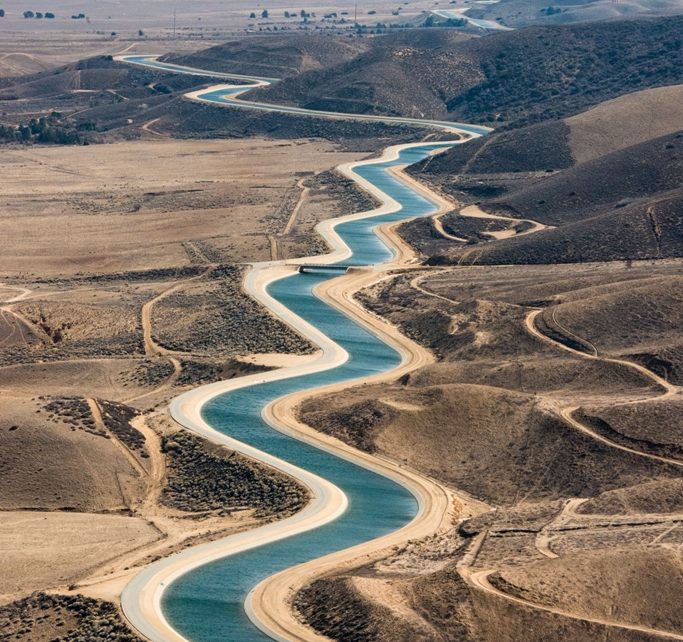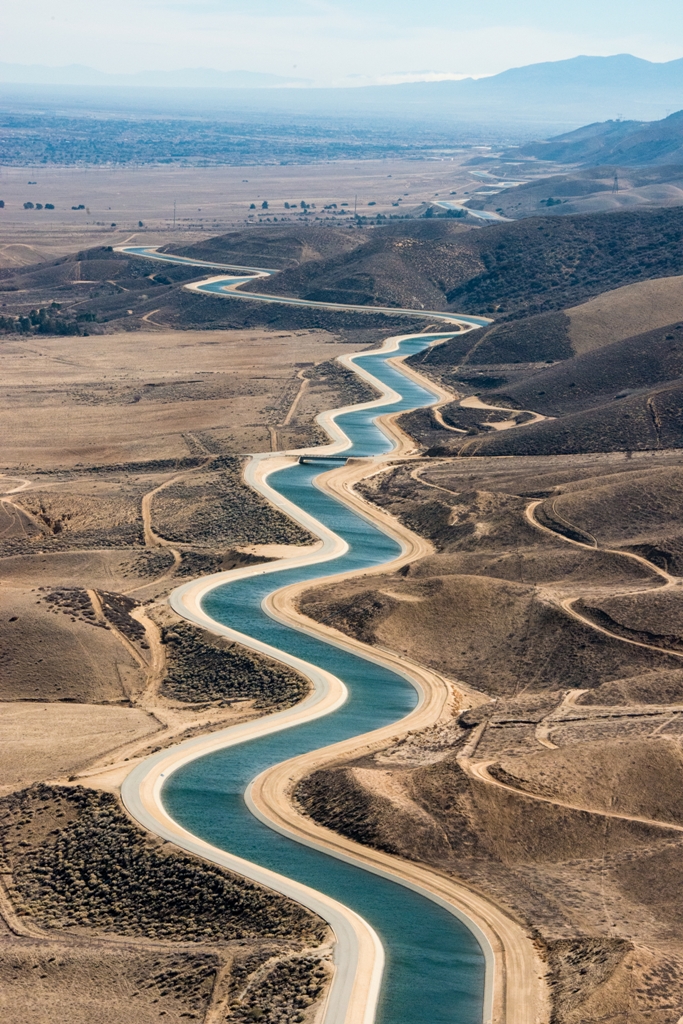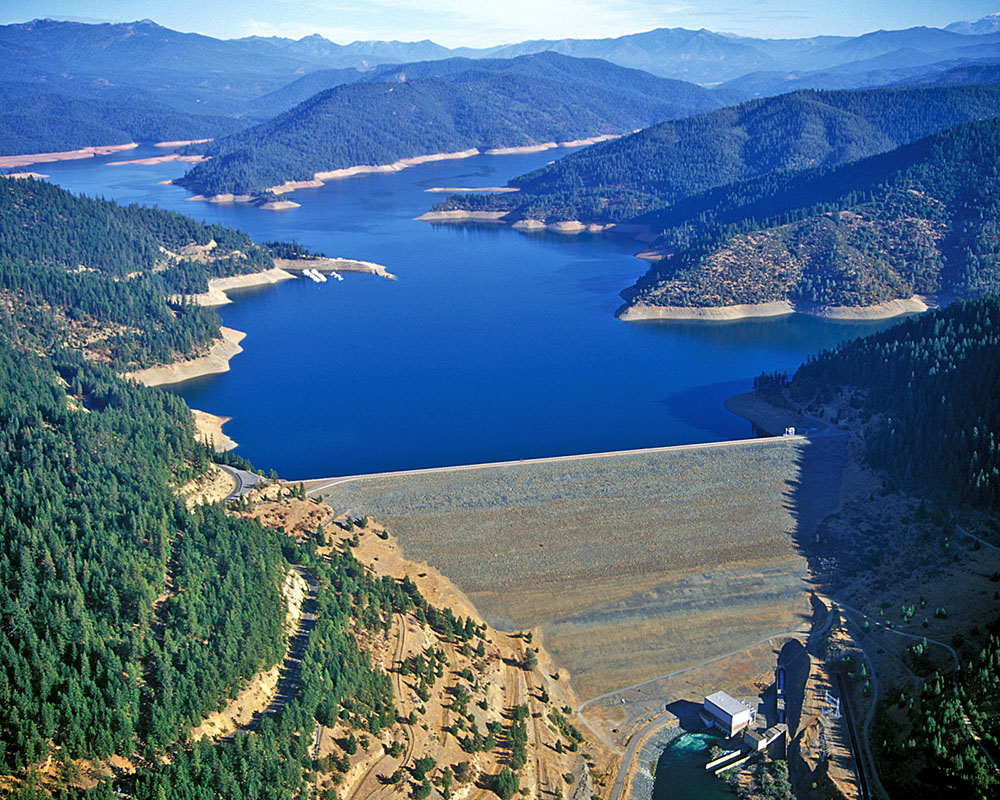
The California Aqueduct. (Photo: CA State Water Project)
Is Water and Power Rationing California’s Future?
The Golden State is feeling more like an emerging market economy in a developing nation
By Katy Grimes, October 23, 2019 2:04 am
Tuesday, another text message warning came in from Pacific Gas & Electric that power outages are imminent. Again. Couple that with a same-day heads-up message from the El Dorado Irrigation District that when the power is out, they cannot pump water to homes and businesses, and California is feeling more like an emerging market economy in a developing nation.
Californians have recently been treated to power shut-downs on windy days by the Investor Owned Utilities in both Northern and Southern regions. Claiming the power blackouts are for public safety and are needed to reduce any chance of electricity transmission lines again sparking wildfires on dry, windy days, as many as 2 million people were without power during the most recent power shutdown. And now we are looking at another, and another, for “ten years.”
California is also facing legislated water rationing in 2020.
Drug-addicted and mentally-ill vagrants living and defecating on city streets, water and power rationing and outages, and many parts of California are resembling the worst results of a universal government corruption.
Without abundant water and electricity, will the Golden State be able to keep up with the demand and plans for building affordable housing, a high speed train, as well as the constant influx of illegal immigrants?
Power Outages, Rolling Blackouts, Zombie Apocalypse
“Weather conditions can change quickly,” PG&E said. “Out of an abundance of caution, PG&E began providing notice to customers in advance of this safety event through automated phone calls, texts, social media and emails.”
Former California Governor Jerry Brown called this California’s “new normal,” and told anyone critical to get used to it.
However, Gov. Gavin Newsom has decided to fight back, or appears to be putting up a front so as not to be compared to Governor Gray Davis, recalled for mismanagement of rolling power outages and blackouts in 2000.
“Following utility-directed power shutoffs that impacted nearly two million Californians and ahead of another Public Safety Power Shutoff (PSPS) decision by Pacific Gas and Electric (PG&E), Governor Gavin Newsom today demanded that PG&E do more to provide information for customers and take action to reduce the number of customers impacted,” his press statement said Tuesday.
“‘While the immediate goal should be to better manage the current anticipated PSPS event, PG&E’s short-term objectives should include steps to ensure that as few people as possible are impacted by any future PSPS decision,’ wrote Governor Newsom in his letter to PG&E CEO William Johnson today.”
Newsom can deflect and blame PG&E, but the buck always stops with the guy at the top.
Last week, PG&E Chief Bill Johnson told the California Public Utilities Commission to expect blackouts for another 10 years.
This did not resonate with the governor. In his letter to PG&E CEO Bill Johnson, Gov. Newsom demanded $100 in either rebates or credit for each residence affected by the blackout, as well as $250 for each small business, the Globe reported.
“The scope, scale, complexity, and overall impact to people’s lives, businesses, and the economy of this action cannot be understated,” said Marybel Batjer, CPUC president, in a letter to PG&E CEO William Johnson that issued a seven-point directive ordering PG&E to immediately address failures,” Engineering News Record reported.
It appears the governor and CPUC Chairwoman are barking loudly, but are toothless dogs. There is very little sincerity emanating from either statement.
The California Public Utilities Commission “regulates investor-owned electric and natural gas utilities operating in California,” says the CPUC on its website. “Through its oversight over utilities, the CPUC has played a key role in making California a national and international leader on a number of energy-related initiatives designed to benefit consumers, the environment, and the economy.”
Yet through its oversight over utilities since the rolling blackouts of 2000, the CPUC hasn’t put the hammer down on the Investor Owned Utilities to make the necessary infrastructure upgrades and repairs.
Shareholders were happy.
While shareholders were well compensated, this could come to an abrupt halt in PG&E’s bankruptcy.
“Meanwhile, PG&E faces criticism over bankruptcy claimant compensation,” Engineering News Record reported. The utility’s reorganization and repayment plan estimates debt over $20 billion, with $12 billion for claimants and $8.4 billion for fire victims.”
California’s electricity power grid has been legislated into fragility by the California Legislature and recent governors by mandating 33 percent renewable energy (2011) in the mix by 2020, then 50 percent (2015) by 2030, and 100 percent renewable energy (2018) by 2045, relegating nuclear, natural gas and coal to the back room. Combine that with the electric car subsidies and hundreds of charging stations installed up and down the state, and California’s electricity grid is not able to handle the demand in 2019 – or beyond.
Water Shortages and Rationing
Is the future of the once great innovative Golden State homeless zombies, and water rationing and power outages, controlled by the state government?
Just last year Gov. Jerry Brown signed a pair of bills creating permanent residential water rationing standards throughout the state of California, despite that the drought had ended and two winters brought abundant rains.
Senate Bill 606 by Sen. Bob Hertzberg (D-Los Angeles), and AB 1668 by Assemblywoman Laura Friedman (D-Glendale), impose a mandatory limit of 55 gallons per person per day on indoor water consumption beginning in 2020, the Globe reported.
Rather than build much needed, already approved water infrastructure projects for less than the cost of implementing AB 1668 and SB 606, California’s political class prefers to impose controls through water scarcity.
Since year 2000, California voters have approved eight water bonds totaling more than $30 billion, according the the Legislative Analyst’s Office, and approved the construction of two more dams.
On May 9, 2016, Gov. Jerry Brown signed an Executive Order to “make water conservation a way of life” in California, which opened the floodgates for future water rationing legislation.
When the Oroville dam break in 2017 revealed incompetent and corrupt water management practices, it also shone a spotlight on California’s political water decisions.
Since year 2000, with voters approving the eight water bonds totaling more than $30 billion, not a penny has been spent on promised water storage projects. Yet the Legislature and Governor(s) only talk in terms of higher taxes and more water bonds, leaving voters to reason that these monies are really pension taxes, and are not going to the promises of more water.
Is this an “emerging market economy” of a third world country? A friend commented, “emerging market economies are headed upward, not spiraling downward at increased velocity.”
Countries whose governments orchestrate power shortages and ration water and food are usually run by totalitarian regimes.








This is a devastating indictment of California’s failing and failed political “leadership.” It’s time to wake up, California, and toss these incompetents out of office post haste. Our state’s cascading and multiplying societal problems are not the result of natural calamities. These are entirely man-made disasters that will only worsen in the next few years if voters don’t act quickly to take back control and replace our state’s failed political leadership.